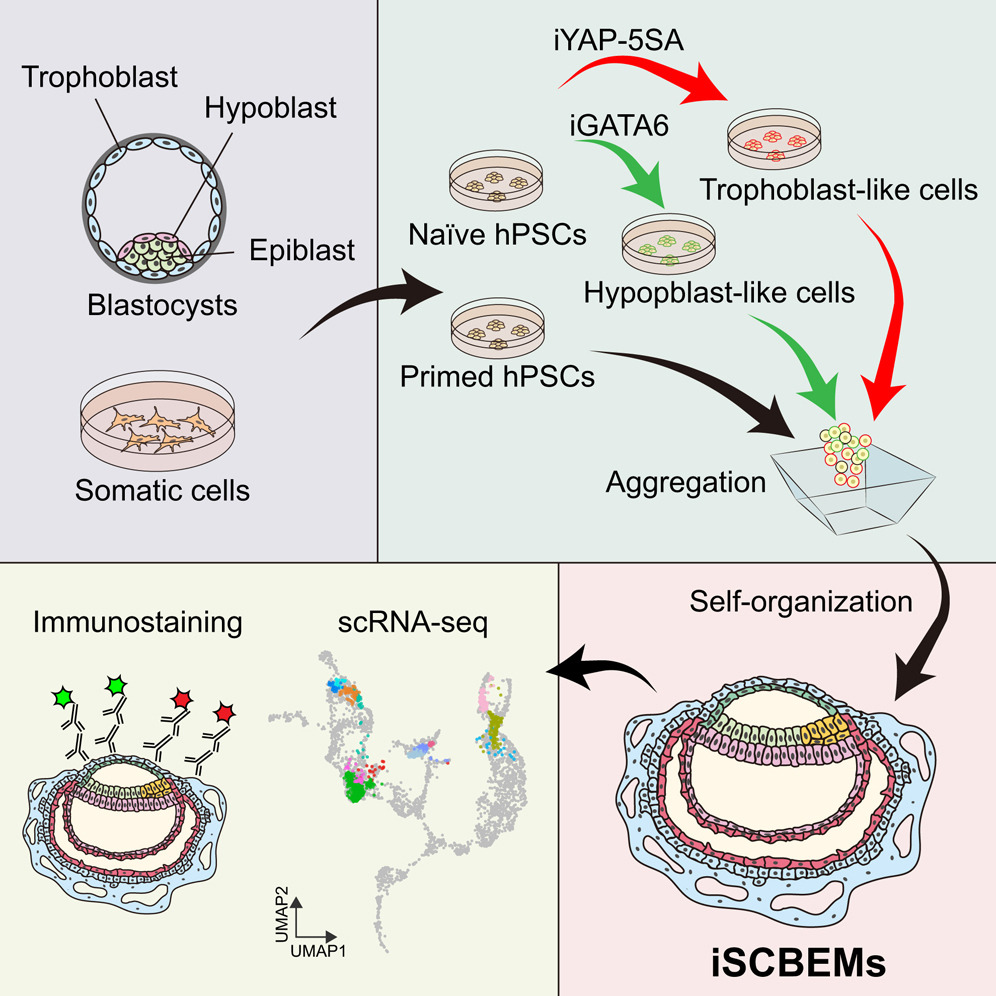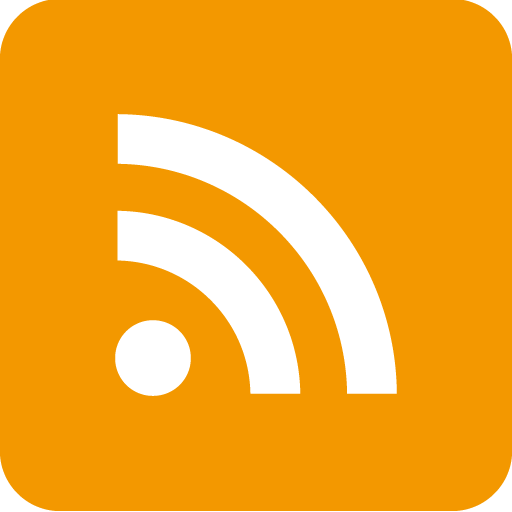This work represents my first first-author original research article as a postdoctoral researcher. We established an integrated stem cell–based embryo model (SCBEM) that recapitulates Carnegie stage (CS) 5–6, by combining human naive pluripotent stem cells overexpressing YAP-5SA or iGATA6 (inducing trophectoderm- or hypoblast-like cells) with human primed pluripotent stem cells. We named this model inducible SCBEM (iSCBEM), as an homage to iPS cells.
iSCBEM recapitulates several key features of early post-implantation development (CS5–CS6), including the formation of amniotic-, yolk sac-, and chorionic-like cavities, differentiation of syncytiotrophoblast-like cells forming lacunae, bilaminar disk formation, anterior–posterior axis establishment, and early gastrulation. Compared with previous reports, iSCBEM overcomes issues of reproducibility and efficiency. Based on the criterion of amnion- and yolk sac–like cavities fully enclosed by trophoblast-like cells, we achieved 38 ± 5% efficiency. A hallmark of iSCBEM is the robust trophoblast specification, which was further validated by scRNA-seq.
Beyond model establishment, our study also provides biological insights into human post-implantation development. Using a protocol that combines epiblast, hypoblast, and trophoblast lineages, we analyzed the unresolved origins of the definitive yolk sac and extraembryonic mesoderm (ExMC). Our results suggest that the yolk sac may derive from the epiblast compartment, while ExMC likely originates from both epiblast and hypoblast. These insights highlight the unique value of SCBEMs in studying human embryogenesis, where direct access to post-implantation embryos is not feasible.
Nevertheless, iSCBEM still has limitations:
- Instability in later culture: From Day 6, structural variation increases, and after Day 8, the models collapse. At Day 7, internal structures sometimes break through the trophoblast layer.
- Absence of EVT differentiation: Despite robust trophoblast induction, extravillous trophoblasts were not observed, likely due to the floating culture system. Embedding in endometrium organoids may improve this.
- Low efficiency of anterior–posterior axis formation: Possibly influenced by gravity or lack of physical confinement in floating culture.
- Immature amnionic ectoderm specification: Surface ectoderm markers were robustly expressed, but differentiation into mature amnionic ectoderm remained inefficient.
Although these limitations remain, our work lays the foundation for future optimization of culture conditions, which we consider the most critical next step.
The field of SCBEM research is rapidly and competitively evolving, yet integrated SCBEMs modeling human post-implantation embryos still require substantial improvement. Moving forward, we aim to establish even more robust and faithful models, thereby contributing to the elucidation of the black box of human embryogenesis.
ポスドクでの1本目の筆頭原著論文です。ヒト naive型多能性幹細胞から YAP-5SA または iGATA6 の過剰発現により誘導した Trophectoderm 様/Hypoblast 様細胞と、ヒト primed型多能性幹細胞を混合し、Carnegie stage (CS) 5–6 を模倣する integrated stem cell–based embryo model (SCBEM) を作成しました。TEとHYPを誘導により作成していることから、本モデルは inducible SCBEM (iSCBEM) と名付けました(iPS 細胞へのオマージュです!)。
iSCBEM は、CS5–CS6 に特徴的な着床後初期の発生イベント、すなわち amnion 様・yolk sac 様・chorion 様腔の形成、syncytiotrophoblast 様細胞の分化と lacunae 形成、bilaminar disk 形成、前後軸の樹立、初期原条形成などの際現に成功しております。これまでの報告に比べ、再現性と効率の課題を大きく克服しており、特に amnion 様腔と yolk sac 様腔が trophoblast 様細胞で覆われた構造を基準にした場合、38 ± 5% の効率に達しています。さらに trophoblast の強力な誘導が大きな特徴であることを示し、scRNA-seqの解析でも既存モデルを上回ることを示しています。
本研究はモデル構築の報告にとどまらず、ヒト着床後発生に関する生物学的知見も提供しています。具体的には、Epiblast・Hypoblast・Trophoblast の3系統を混合する系を利用し、起源が未解明であった definitive yolk sac や extraembryonic mesoderm (ExMC) の由来を解析しました。その結果、yolk sac は epiblast 由来である可能性、ExMC は epiblast と hypoblast の双方に由来する可能性を示唆しました。これは、実際のヒト胚への直接的アクセスが困難な中で、SCBEM だからこそ得られる重要な知見だと考えています。
もっとも、iSCBEM には課題も残されています。
- 培養後期の不安定性:Day6以降に構造のばらつきが増し、Day8以降は崩壊。また Day7 には内部構造が trophoblast 層を破って露出する場合もある。
- EVT の誘導欠如:robust な trophoblast 誘導はあるが EVT は観察されず。floating 培養に起因すると考えられ、endometrium organoid 埋め込みなどの工夫が必要。
- 前後軸形成の低効率:重力や物理的 confinement などの要因が影響している可能性。
- Amnionic ectoderm の未熟性:surface ectoderm のマーカーは robust に発現するが、十分に成熟した amnionic ectoderm には至っていない。
このように、現在の培養条件に至るまで検討を重ねてきたものの、培養条件の最適化が依然として最大の課題です。
SCBEM 研究は盛んに進んでいますが、特に ヒト着床後胚を模倣する integrated SCBEM は依然として改善の余地が大きい領域です。今後さらに robust に発生を再現できるモデルを確立し、ヒト胚発生のブラックボックスの解明に貢献していきたいと考えています。
Summary
Early post-implantation human development is poorly understood due to limited access to natural embryos. Integrated stem cell-based embryo models (SCBEMs) offer an alternative, but current models face challenges in reproducibility, efficiency, and genomic stability. Here, we developed inducible SCBEMs (iSCBEMs) by combining primed human pluripotent stem cells (hPSCs) with transgene-induced extraembryonic cells derived from naive hPSCs. iSCBEMs recapitulate several key features of early post-implantation development, including amniotic-, yolk sac-, and chorionic-like cavity formation, differentiation of syncytiotrophoblast-like cells forming lacunae, bilaminar disk formation, anterior-posterior axis establishment, and early gastrulation. Single-cell RNA sequencing revealed that iSCBEMs recapitulate key cell types and developmental transitions characteristic of Carnegie stage 5–6 (CS5–CS6) embryos. We further traced the origins of amnion-, yolk sac endoderm-, and extraembryonic mesoderm-like cells, providing insights into their developmental trajectories. Although imperfect, human iSCBEMs represent a robust and valuable model for studying early post-implantation development, overcoming the limitations of natural embryo accessibility.
Graphical Abstract

https://www.sciencedirect.com/science/article/abs/pii/S1934590925002978
https://www.cell.com/cell-stem-cell/abstract/S1934-5909(25)00297-8
